Have you found confusion resulting from not knowing what ratio to use when you make cold brew coffee batches? Not sure what the "1:3" jargon means when referencing the process?
Have no fear, Cold Brew Hub is here to help you get through this tight spot! In this article, we aim to demystify cold brew coffee ratio jargon and deliver some actionable information so you can get off the computer, and get back to brewing your delicious cold brew.
Let's start the demystifying process by clearing up the big whopping mistake many noobs make when referring to cold brew. Cold Brew is not Iced Coffee. So pour out your iced coffee and drink cold brew instead.
Iced Coffee is Not Cold Brew & Vice Versa
As you know, cold brew coffee is different from standard iced coffees since we make it with cold or room-temperature water. The coffee grounds are never touched by hot water, giving them a very distinct flavor and character.
When making iced coffee, you still use boiling water to brew the coffee. Then you'll quickly chill it, resulting in a diluted and often bitter tasting iced coffee. In my opinion, iced coffee is a terrible compromise when you have cold brew available.
Even more, what if you don't want to pay the high cost of a cold brew coffee at a coffee shop every time you need a caffeine fix?
If you make your cold brew coffee at home with the right grounds to water ratio, you will still get the buzz you want. The caffeine you get in your regular cup of coffee that keeps you going all day may leave you with a harsh effect on your stomach.
Still, you won't experience stomach pains from a cold brew. Let's explore what cold brew is a little more before we get to the ratios. You can also click on the table of contents button to skip, if you prefer.
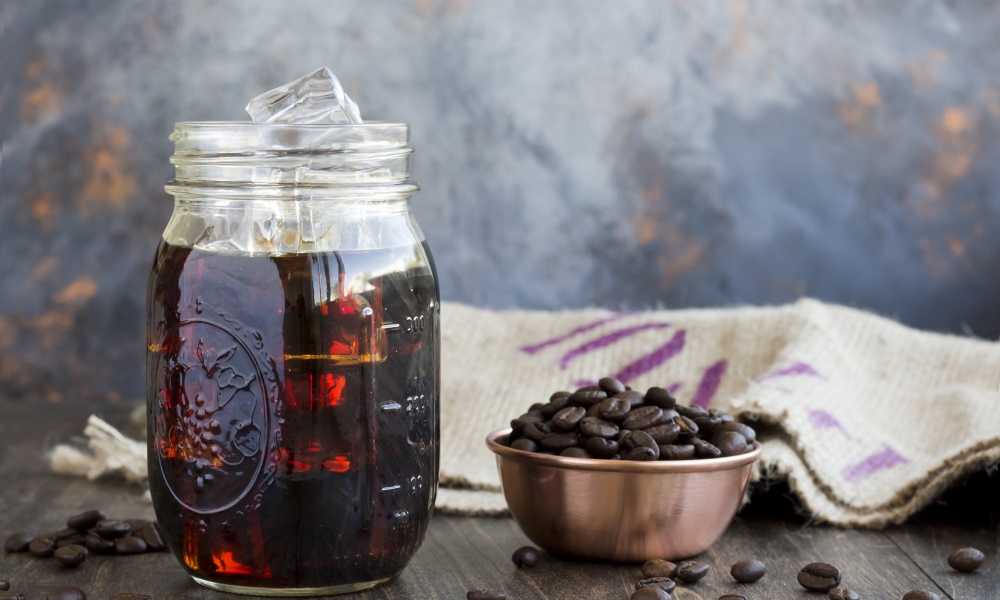
What is the Difference Between Cold Brew and Iced Coffee?
Cold brew dramatically differs from your usual brewing method.
Hot coffee depends on specific temperature ranges to achieve distinct flavors, while cold brew coffee depends mostly on time.
Coffee brewed in boiling or near-boiling water releases acids and fats from the coffee beans, which are more soluble at higher temperatures. The added soluble result in a more acidic and slightly bitter flavor profile that appears within minutes of mixing the beans with hot water.
On the other hand, cold brew coffee, uses cold or room temperature water when brewing; the strength and flavors rely on how long the grounds remained submerged in water.
This cooler water results in a stronger, yet smoother taste, as the sweet compounds found in the beans, such as Furaneol, extract. Interestingly enough, these sweeter compounds take much longer to absorb in cold water, taking nearly 12 hours to 24 hours steeping period to release.
Coffee brewed this way is approximately 60% less acidic than hot coffee and doesn't carry the burnt taste and bitter underlying notes that are prevalent with hot coffee.
So, What's with the Hype around Cold Brew?
Let's break it down:
- You get a much slower released caffeine hit, which means you get no caffeine crash
- It is less acidic and more mellow than iced or hot brewed coffee
- It is easier to drink and gentler on the stomach than regular coffee
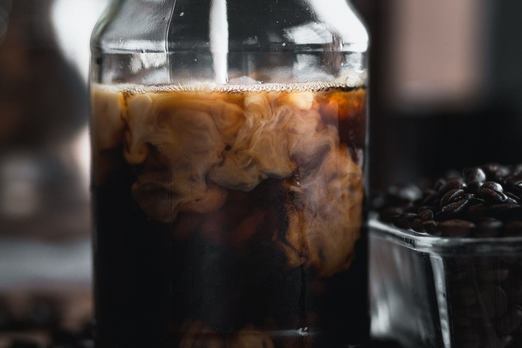
- Cold brew coffee can last for up to 14 days in the refrigerator making it more convenient to stock up
- You can make cold brew coffee concentrate which can be diluted and used in different recipes
Ratio, Grind, & Caffeine
Your preference of coffee grounds to water ratios will change based on the cold brew recipe you choose and will differ slightly from person to person as well.
Note: Personal taste dictates what ratio is right for your cold brew.
Still, many wonder what the best ratio is for cold brew, so let's get to that now.
What is the best cold brew coffee ratio? More like Pre-Ratio
This is the pre-ratio that signifies the amount of coffee grounds and water you use before brewing. Stay with me.
At cold brew hub, we break down cold brew ratios into 3 strengths (weak, regular, and concentrate), and the ratios for each, we refer to as parts of water to parts coffee grounds.
Picking out the perfect pre-ratio for cold brew can be tricky if you aren't sure what the measurements (parts are), so let's look at those.
The standard for weak cold brew is for every 1 gallon of water, you’ll need 1 pound (lb) coarsely ground coffee. That is a 1:1 ratio in our book. If you increase the amount of coffee, you will brew a stronger batch until you brew a concentrate.
While, debates are raging online about the exact number of beans to use, some calling for a 1:5 ratio, others recommend a 1:3 ratio, I tend to stick to a 1:3 myself when brewing a concentrate. To me, that means I put in 1 gallon of water per 3 lbs of coffee for a standard immersion brew.
We've created a section below that will show you various ways to measure water and coffee. Keep in mind that all measurements under the "WATER" column are equal, and all measurements under the "GROUNDS" column are also equal.
If you're cold brewing a weak batch, then...
for every (1 cup = 8 oz. = 236 ml) of water, add ( .5 oz. = 15 grams = 1 tbsp) of grounds
Since there are many ways to measure liquids and many ways to measure solids, it can be pretty confusing to know what someone means by a 1:1 ratio for brewing, but most people brew by the gallon.
Look to the tables below to see the cold brew ratios we use for brewing.
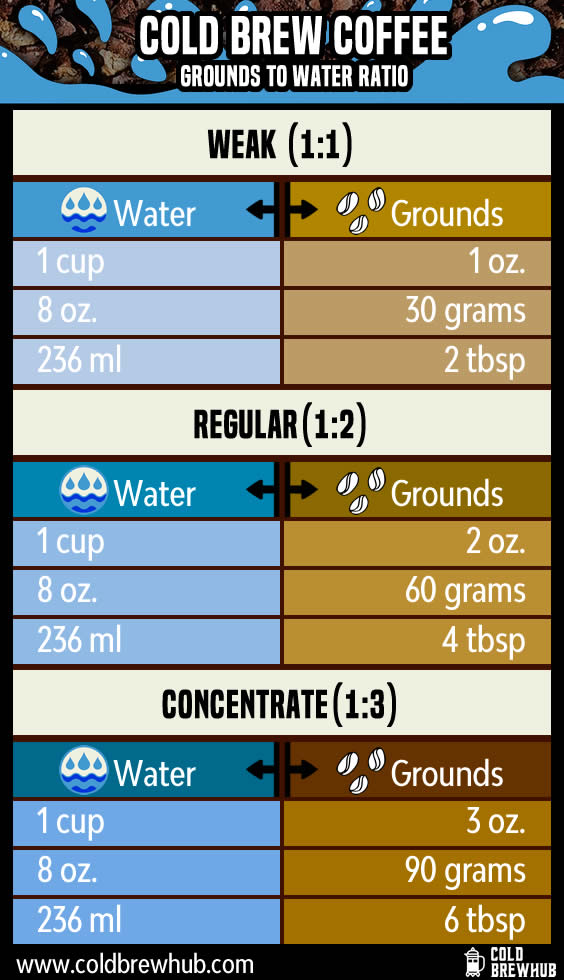
You may see some other cold brew ratios out there. Some of them include using a singular method of measurement, like grams for example, or multiple cups of water.
The trick is to pick one measurement and then stick to it when you want to make cold brew.
Remember that the more grounds you use, the stronger the batch will be. What's more, you can always dilute a strong cup, but it is challenging to strengthen a weak brew.
If you are a beginner, try following these French press instructions, since most people have one. If you don't have a French press, you can also use a mason jar.
Since a standard 32 oz French Press makes 4 cups, we will place 120 grams of coffee in the French Press, and fill the rest with water. This ratio will brew a "weaker" cold brew batch.
This of your coffee and water ratios like this: The more coffee grounds you add, the stronger the brew will be.
You won't need to use a coffee maker or a drip machine for this brewing process, as it uses the immersion or a steeping technique. If you have a massive French press, a mason jar, a pitcher, or a jug with a lid, you can always double or triple the coffee grounds depending on the container size.
What is the best grind for cold brew coffee?
You'll have more success with your cold brew task if you choose a medium to coarse grind for most applications. Otherwise, you'll need to take an extra filtering step to strain the smaller grind from the mixture.
You May Be Interested in:
Keep in mind that the caffeine content within cold brew coffee concentrate is higher than hot brewed due to the higher concentration of coffee grinds to water. The cold brew coffee ratio is higher than with other conventional methods of brewing coffee, in most cases.
What about caffeine content when you make cold brew coffee?
Coffee that came from a cold brew batch at 400 grams may contain up to 200 mg of caffeine, while a hot cup of traditional coffee may contain 170 mg.
The caffeine content all depends on how long you steep your cold brew coffee and whether you add water or creams to it. When the batch is too strong many people choose to dilute their cold coffee brew concentrate with either water or milk.
What Type of Coffee Beans do I use for My Cold Brew Ratio?
Depending on how you like to drink your coffee, the type of coffee will vary. Here are a few examples:
- Floral Notes: African coffee is lower in acidity and provides a pleasant and citrusy flavor with undertones of berry and jasmine, which are enjoyable without any additives.
- Chocolate Notes: If you prefer your coffee with milk, cream, or a chocolatey richness to your drink, then choose a more suitable medium roast coffee from Latin origins.

- Spicy Notes: Dark roast Asian and pacific coffee beans offer a more profound flavor with notes of vanilla and chili; these are most suited for coffees mixed in rich cream or condensed milk.
If you love to drink cold brew black, then the best coffee beans you can find from Africa are the most preferable choice to use for your cold brew concentrate.
You May Be Interested in:
Check out the map below to see regions where coffee is grown and then tap or click on the region to see it's flavor profiles.
How to Make Cold Brew Coffee
Now that you have an idea of what steps you need to take to prepare your cold brew batch, let's start making cold brew coffee. There are more detailed instructions here, but here is the gist of it.
Let's say you have ground your coffee beans and added the water to a pitcher of some kind. Go ahead and give it a good stir for around 2 minutes to thoroughly saturate all the coffee.
You don't want any dry air pockets in the coffee grinds and water mixture to occur; otherwise, you will not get the full effect of the cold brew steeping process.

The grinds will float to the top, but that is ok to ensure they extract fully. Put the lid back on your French press, but don't press it.
If using a pitcher or jug, be sure to cover it before leaving it to soak for 12-16 hours at room temperature.
If you would like stronger coffee, you can achieve that by steeping it for up to 18 hours if left at room temperature or no longer than 24 hours in a fridge.
Steeping your brew for more than 24 hours is not recommended, as this will alter the flavor, making it taste dusty and bitter.
Make sure that the place that you leave your cold coffee brewing is not somewhere that can easily topple over.
Also, ensure that it is out of direct sunlight. Heat can interact with the cold brew steeping process and alter the taste of the coffee. It will produce a bitter or dusty flavor, just like steeping for too long.
When you are ready to filter out everything, pour the cold brew batch with the grounds in it through a sieve or filter and remove the grounds. It is best to do this process slowly and in batches and try to avoid squeezing the coffee grinds as this will release a bitter flavor from the grounds.
Now let's talk about the next confusing bit about ratios. The dilution ratio. We also call this the post-ratio.
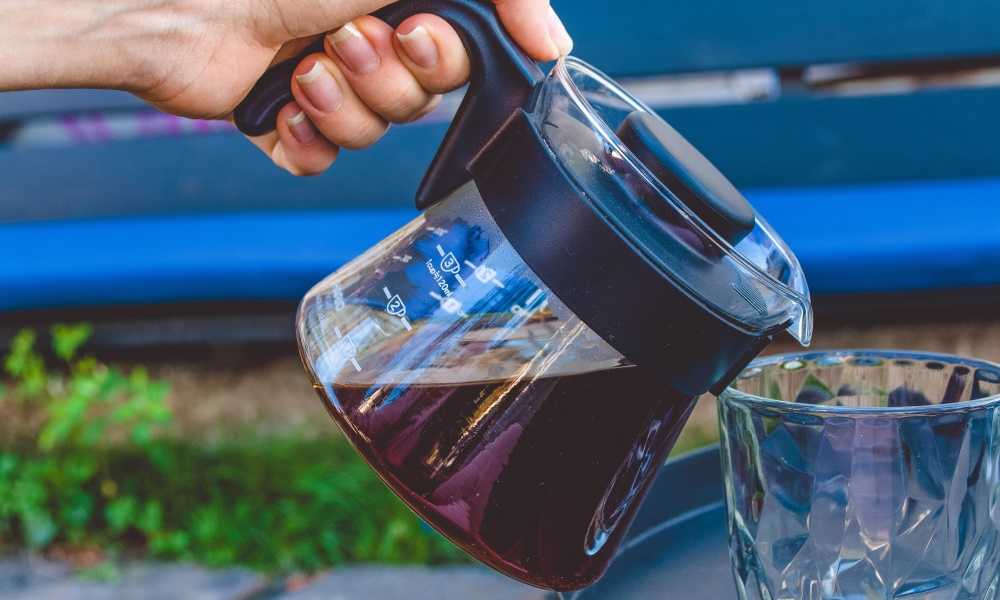
Making Cold Brew with a Concentrate Using a Post-Ratio
It is quite simple to make your cold brew coffee once you have made your concentrate as it is ready to drink. Still, you'll want to dilute it if you brewed it strong (1-3 pre-ratio).
If you prefer stronger coffee, use a post-ratio of 1:1. If you would prefer a more mellow cold brew, use a ratio of 1:2. You can mix the concentrate with milk, water, or a mixture of both to get a more diluted coffee concentrate. Make sense?
That is grab a 20 ounce glass and add a cup of cold brew and then add a cup of water to it. Next, add in a couple ice cubes, and finish it off with flavor additives or foam. Easy as that.
The standard for a finished strong cold brew at cold brew hub is 1 cup cold brew concentrate(1:3 pre-ratio) to 1 cup water. This will result in 16 ounces of a tasty af beverage you can drink, with room for ice and foam if you wish.
You can dress up your ready to drink brew in several ways. For a morning coffee, adding a splash of cream or milk without adding water to your coffee cold brew concentrate will give you a strong coffee shot.
For a more luxurious coffee experience, make milk or cream ice cubes and use that in your cup without the need to add water or lowering the coffee's temperature.
Note: You can always dilute it, but you cannot make it stronger after brewing.
Once you have mixed the concentrate with water or milk to your desired blend, you can add cream, sweetener, sugar, or flavored syrup to suit your preferences. If you want a pure flavor blast, be sure to add an essence like almond, vanilla, or hazelnut flavoring.
Cold Brew Concentrate Uses & Recipes
You can also create your own cold blended coffees and frappe recipes at home with cold brew coffee concentrate that you can adjust to your taste.
Having a cold brew on hand in the fridge that is ready to use will make it easy to create different drinks to enjoy. You can simply add ice, milk, and sugar to your cold brew coffee to your liking, or use one of the below recipes for inspiration.
Vietnamese Cold Brew Coffee
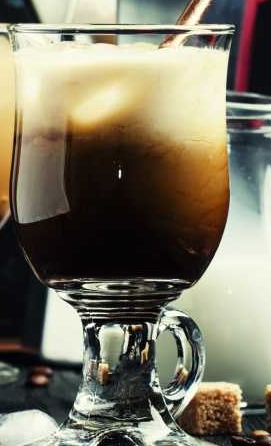
Yield
Post-Brew Ingredients
Prep Information
INSTRUCTIONS:
Vietnamese Cold Brew Coffee is one of the easiest coffees to make with cold brew coffee concentrate. It only uses three ingredients and offers the same punch the original drink calls for with its use of Vietnamese dark roast coffee.
- Add Vietnamese concentrate and water to a 20 Oz glass
- Add Condensed Milk
- Top with Ice Cubes
- Enjoy
Blended Caramel Coffee Frappe
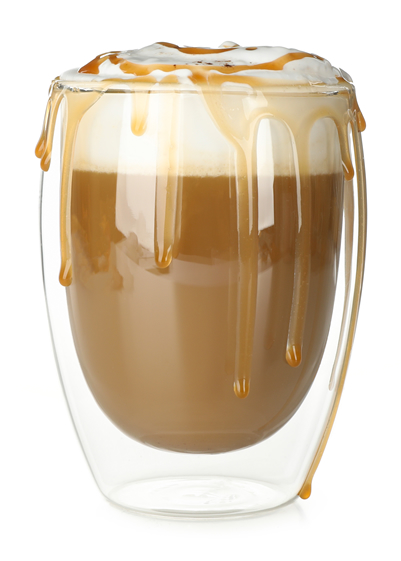
Yield
Post-Brew Ingredients
Prep Information
INSTRUCTIONS:
Instead of opting for a expensive store-bought cold coffee frappe, you can make the frappes you love using this recipe.
- Add concentrate and Milk Ice Cubes to a blender
- Blend on High until Creamy
- Add pitted dates and blend until mixed thoroughly
- If your cold brew coffee concentrate is robust, add a little water to the mix and dilute as desired.
- Add whipped cream to the top
- Drizzle Caramel Syrup as desired
- Enjoy
You can use the same blended coffee frappe recipe to make a mocha frappe. Just switch out the dates and use two tablespoons of cocoa powder and drizzle chocolate syrup instead.
Irish Cold Brew Coffee
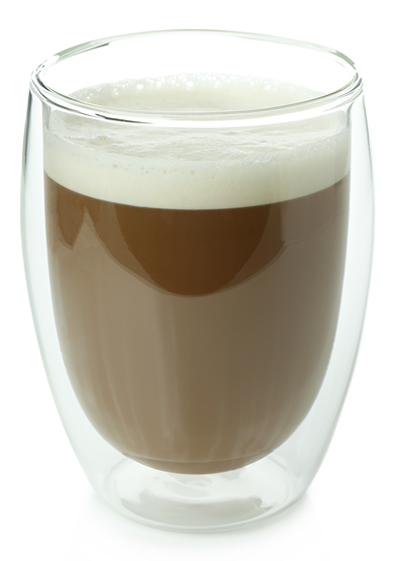
Yield
Post-Brew Ingredients
Prep Information
INSTRUCTIONS:
Traditionally, Irish coffee is a hot beverage, but cold brew adds a fun twist to the original. Just add all the ingredients together in a glass, and you will have the ultimate cold brew Irish coffee drink. You can also add a dollop of whipped cream on top for extra richness
- Add Concentrate and water to a shaker
- Add Simple Syrup and Fresh Cream to shaker
- Add Irish Whiskey and Ice to shaker and shake well
- Empty contents into a 20 Oz glass leaving the ice behind.
- Top with whipped cream
- Enjoy
Other Uses for Your Cold Brew & Used Coffee Grounds
You can also use your cold coffee brew concentrate with syrups for ice cream toppings. Use it as a flavoring agent to cookies and desserts, or add a few tablespoons to a hot chocolate cup to kick it up a notch.
Don't throw away your grounds! You can do so many things with them, that it is simply a waste to throw them out.
You May Be Interested in:
FINAL THOUGHTS
Cold brew coffee is a very versatile drink in that you can use cold brew in a variety of ways. Getting the right cold brew coffee to water ratio is very important when looking at the flavor. Adding too much can result in overpowering, strong coffee.
Adding too little will give you weak, watery coffee with no character. The perfect cup of cold brew coffee will emerge through trial and error. However, by following the above steps, you can learn how to brew YOUR best version of cold brew.
If you love experimenting with your cold brew, share with us your notes on your favorite homemade cold brew coffee recipes in the comments below. We love sharing recipes with the community!
